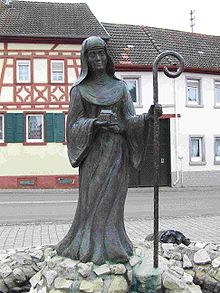Institute of St. Boniface

The Institute St. Bonifatius is a mission-benedictine secular institute , under canon law an institute of consecrated life in the Catholic Church . The members live and work according to the example of St. Boniface and St. Lioba von Tauberbischofsheim , you want to serve people as messengers of faith.
history
The idea of founding a women's community arose in the post-war years between 1945 and 1947. A group had come together in the Schweiklberg Abbey in Vilshofen on the Danube near Passau and decided to work together: They wanted to help children and young people in need, give them an education and give them a Christian education. In addition, the women had been involved in helping refugees. The Benedictine community was founded on Easter 1949 by Fr. Cyprian Mayr OSB (1907-1992). The community took on its first service in the Haus Nordmark children's health home in Westerland on Sylt. At the same time, the community was involved in the work of island pastoral care.
In 1950 the community set up its center on Kupferberg 1 in Detmold . In 1978 it was recognized as an institute under papal law . In the 1960s, the St. Bonifatius Institute developed into a worldwide organization. The first members went to Guatemala in 1965 and to Rwanda in 1966 . In 1978 the community was recognized as an institute under papal law .
Life form
The women who live in the midst of people lead a consecrated life according to the rule of St. Benedict . They make profession and promise a life in poverty, celibacy and obedience according to the evangelical counsels . The members live either as a single person or in small groups. The two-year training takes place on the various continents in the respective regional centers of the community, in Europe partly in the training group in Münster , and ends with the first profession . After a further nine years, the vows are taken for life.
structure
The St. Boniface Institute has around 180 members worldwide. The headquarters and the administrative center of the community have been located on the Kupferberg in Detmold since 1951 . Other groups of the community work in Great Britain (London), Italy (Rome), Norway, Spain. A total of 119 members are active in Europe. Nineteen members serve in Rwanda and the Democratic Republic of the Congo , and 50 in Guatemala .
See also
literature
- Christa von Gleichenstein, Maria Lohre: “Act, don't complain!” Life picture of Father Cyprian Mayr OSB (1907–1992), founder of the Secular Institute Saint Bonifatius . eos, Sankt Ottilien 2017, ISBN 978-3-8306-7818-2 .
Web links
Footnotes
- ↑ Christa von Gleichenstein, Maria Lohre: “Act, don't complain!” Life picture of Father Cyprian Mayr OSB (1907–1992), founder of the Secular Institute Saint Bonifatius . eos, Sankt Ottilien 2017, p. 115.
- ↑ Christa von Gleichenstein, Maria Lohre: “Act, don't complain!” Life picture of Father Cyprian Mayr OSB (1907–1992), founder of the Secular Institute Saint Bonifatius . eos, Sankt Ottilien 2017, p. 143.
- ↑ Christa von Gleichenstein, Maria Lohre: “Act, don't complain!” Life picture of Father Cyprian Mayr OSB (1907–1992), founder of the Secular Institute Saint Bonifatius . eos, Sankt Ottilien 2017, p. 199.
- ↑ Christa von Gleichenstein, Maria Lohre: “Act, don't complain!” Life picture of Father Cyprian Mayr OSB (1907–1992), founder of the Secular Institute Saint Bonifatius . eos, Sankt Ottilien 2017, p. 203.
- ↑ Annuario Pontificio , 2017 edition, p. 1662.
- ↑ Lothar Stresius: Monasticism and religious life . In: Erbe und Einsatz , Vol. 93 (2017), p. 472.
Coordinates: 51 ° 56 ′ 6.7 ″ N , 8 ° 48 ′ 47.8 ″ E